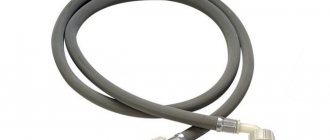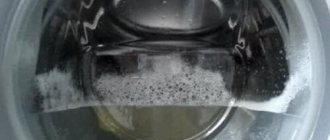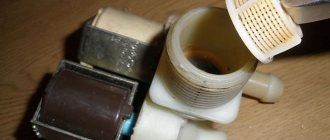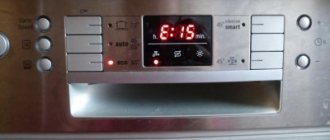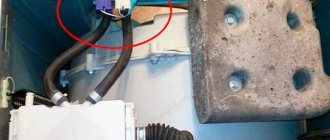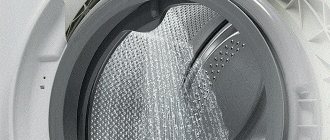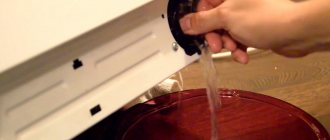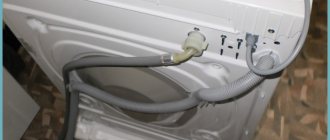You loaded the laundry, set the desired program, and the washing machine began to fill with water. In the first minutes, everything was going normally, but at some point it became clear that the collection of water did not stop at the right moment, and there was a lot of water in the drum.
Note! In some cases, its level can even rise to half the tank.
After this, the drain pump turned on, the water that entered the drum went into the sewer, and the machine stopped washing and displayed an error message in the form of a message on the display or a combination of flashing indicators. If this happened to your washing machine, then you are faced with an overflow of water into the machine.
Attention! Do not confuse overflow with a similar problem where the washing machine constantly fills with water. In this case, the normal amount of water is poured into the drum, it is simply drained at the same time, so the machine is forced to constantly add water. The execution of the program may not stop until the owner stops the machine manually. If your machine constantly takes on water, read another article.
How dangerous is water overflow in a washing machine?
Many non-professionals who do not understand the structure of washing machines “scare” users with the dire consequences of overflowing. They say there is a high risk of flooding your neighbors or flooding the electronic control unit of the car itself. In fact, most modern washing machines have built-in overfill protection. As soon as the water level in the tank reaches a critical level, the overfill protection is triggered, the water is drained, and the device displays an error message. The risk of flooding your neighbors or damaging the electronic components of the device itself exists only in very old automatic machines, mostly domestically produced.
The reason why a washing machine overflows water, according to the experience of the RemBytTech workshop, most often lies in a breakdown. Only in rare cases can the problem be fixed on your own.
Is it possible to repair the SM yourself?
If the washing machine overflows water, the cause of the malfunction is not always equipment failure. Overflow may be associated with a failure of the control module due to voltage surges in the network. In this case, you can perform simple repairs yourself. To do this, you need to turn off the equipment (including from the outlet), wait a few minutes, turn it on again and try to start the device.
If the washer still overflows water, then the problem is related to a breakdown of one of the CM units. In this case, you need to turn off the washing mode and drain the liquid using the button on the unit. In case of serious malfunctions, the button may not work and you will have to use an emergency drain hose. After checking, you need to call a washing machine repairman.
The washing machine pours a lot of water - when you can fix it yourself
If the problem occurred for the first time, then there may have been a one-time failure of the control module. There is only one solution - unplug the washing machine from the outlet for a few minutes, and then turn it on again.
If “rebooting” the device did not help, then most likely one of the machine components has failed. Most likely, the water overflow is caused by a malfunction of the pressure switch (water level sensor). According to statistics, in 90% of cases the reason why the washing machine takes in a lot of water is a failed pressure switch.
What happens if the washing machine overflows water?
If the pressure switch does not work in time, the problem will manifest itself as follows:
- The washing machine will continue to fill the tank. There is a similar breakdown in which the SM simultaneously fills and drains the contents of the tank. That is, water does not linger inside the device. This is a completely different problem. When overflowing, the equipment fills with a lot of water, which can be seen through the glass of the hatch.
- The electronics will detect excess liquid inside the machine and give a command to remove it.
- The pump will start working. It will drain all the liquid down the drain. Even though the washer has previously collected a lot of water, only your clothes will remain in it.
- The washing will stop and an error message will appear.
Possible breakdowns
Based on the experience of RemBytTech specialists, we have compiled a list of the main breakdowns that lead to water overflow. You can check them out below.
Faulty pressure switch (level sensor) - from 1400 rubles.
The pressure switch tube has fallen off, become clogged or damaged. The pressure sampling chamber of the level sensor is clogged with scale and dirt, or the sensor itself has failed.
Signs
The washing machine collects a large amount of water (its level can reach the middle of the drum), then immediately drains it, stops the washing program and displays an error message (water level sensor).
How to fix
If the pressure switch tube has fallen off, become clogged or damaged, it is necessary to put it back on accordingly, blow it out or replace it with a new one. A clogged pressure switch chamber must be cleaned. If the sensor itself fails, it must be completely replaced with a new one.
Faulty electronic controller (control module) - from 2000 rubles.
During flooding, the controller does not give a command to stop drawing water, and it continues to flow into the machine.
Signs
The washing machine overflows water, after which the water is drained and the wash stops. It is also possible that the machine displays an error in the form of a combination of flashing lights or a message on the display.
How to fix
The control board needs to be repaired or completely replaced.
The filling valve is out of order - from 1500 rubles.
It is stuck in the open position, so water constantly flows into the machine and it cannot finish the program.
Signs
The washing machine constantly draws water after starting the wash or when switching to rinse. The program does not complete and an error may appear.
How to find the cause of the breakdown?
How to find the reason for the constant flow of water into the tank of the machine?
To detect the problem, you must perform the following sequence of actions:
- Check that the washing machine is connected correctly to the sewer. The cause of the malfunction may be that the sewer pipe is located directly on the floor.
- Check if there is a puddle of water under or near the washer. The machine tank or inlet hose may be leaking.
- If it was not possible to identify the cause of the breakdown in the previous stages, then you need to check the inlet valve, as well as the pressure switch. To do this, you will need to disassemble the washing equipment.
- If the pressure switch, intake valve and their sensors are working properly, then the cause of the breakdown is the electronics. To test the control unit, you need to invite a specialist.
So, if your washing machine is constantly filling with water, then it is unsafe to use it in this condition. The problem may get worse. Try to find the cause of this malfunction yourself or seek help from specialists.
The control module is broken
Failure of the electronic control board can occur for various reasons:
- network voltage jumps;
- high humidity in the room, etc.
Due to a malfunction of the control module, problems may arise not only with water overflow, since in fact this board is the “brain” of your washing machine. In the situation we are considering, the command from the control board to stop water intake is not executed, so the flow into the drum does not stop. After the water overflows, it is drained and the washing program stops; the LEDs on the control panel may begin to flash and show an error. A broken control board will have to be taken to a workshop or replaced with a new one.
Washing machine control module
Such a breakdown is a rare occurrence, and Asian brands like Samsung are more susceptible to it. Original assemblies of European brands (for example, Italian Indesit) are more resistant to the influence of the adverse factors described above.
Washing machine repairman at home
If you find that your household appliance is constantly overflowing water, do not try to solve the problem yourself. Trying to repair it yourself can complicate the situation, contact a professional. Service offers inexpensive repair of washing machines in Moscow at home. We repair washing machines of all well-known brands, using original components that are always in stock, and professional tools. Qualified technicians will come to your home at the appointed time, carry out competent diagnostics and fix the problem in a short time, and provide a guarantee for the installed spare parts and services. To call a specialist, fill out the online form or call 8(495) 213-33-33
.
Let's check the drain hose
Diagnostics of the Indesit washing machine should be carried out from simple to complex. First of all, it is recommended to check the connection of the machine. Most often, Indesit washing machines keep drawing water due to an incorrectly connected drain hose.
The equipment always comes with instructions that describe in detail the process of connecting the machine to house utilities. The main rule is that the drain hose must be positioned at a height of 50-60 cm from the floor. If you extend the hose lower, the water will be removed by gravity into the pipe, the pressure switch will send a signal about the empty tank to the “brain”, and the control center will give the command to fill the system with water again. And so on in a circle.
You can check if this is the reason visually - just inspect the sleeve and make sure that it is at a sufficient height. If inspection is not possible, it is possible to evaluate the position of the hose in another way:
- turn on any washing program;
- wait until the tank is full;
- start the “Drain” mode;
- In the middle of the descent, press the "Pause" button.
If the liquid continues to leave the system even when the process is paused, then the problem is definitely in the drain hose. If the water level remains the same, you will have to look for the problem further.
By the way, often the equipment comes with a special loop designed to secure the drain hose. The hose is inserted into the plastic element, thus securing it in the correct position.
What could have gone wrong?
Various factors can cause the Indesit machine to constantly fill with water. Initially, you should identify all possible problems, and during the diagnostic process, narrow down the range of breakdowns. So, what can cause a continuous supply of liquid from the water supply:
- incorrect connection of the washing machine;
- damaged washing machine tank;
- broken pressure switch;
- broken intake solenoid valve;
- faulty control module.
If only the purchased machine showed a problem in the first wash, it is not necessary that it was connected incorrectly. Perhaps there is a normal manufacturing defect. In this case, it is better not to carry out repairs yourself, but to submit the equipment for warranty service to a service center.
The microprocessor control unit is faulty
The control board is the “brain” of the washing machine. It receives and processes signals coming from various actuators, including the pressure switch and inlet valve, and completely controls the washing. Voltage surges and water entering the electronic components of the device (the problem is typical for equipment installed in the bathroom) lead to breakdown of the control module. As a result of this, the machine begins to work incorrectly or does not turn on at all, and various problems are observed, including water overflow. Depending on the complexity of the breakdown, to eliminate the malfunction it is necessary to repair the control board or completely replace the control unit with a new one.
Water appears in a non-working machine
When the liquid in the drum of the device arrives and the machine is in a non-working position, the aquastop system does not work, since the sensor is located in the pan near the floor. All the liquid pours out.
The device fills with liquid if:
- the supply or siphon valve is broken;
- there is no siphon valve at all;
- The drain system is clogged, and all the drainage ends up in the drum instead of the sewer.
To fix the breakdown, you need to turn off the tap through which water flows and disconnect the equipment from the electricity.
Read more ► The washing machine does not spin: causes and troubleshooting, how to fix it without repair
If the drum still fills with liquid, you need to carefully check the connection of the unit. If the drain hose is not connected correctly, the tank of the machine will fill with sewage.
If everything is connected according to the instructions, the reason for the appearance of liquid may be the accumulation of a blockage inside the pipe. Sewage will begin to collect inside the machine.
And since they will have nowhere to go, everything will go down the drain. To fix this, you need to clear the clog.
Inlet valve fault
Malfunction of the inlet valve
Liquid penetration into the drum occurs through a cracked membrane, which is damaged during operation of the device. The membrane inlet channel does not close due to a contaminated area.
A clog creates a favorable environment for the development of microbes and unpleasant odors. To diagnose the problem, turn off the supply valve. If it stops flowing into the drum, then it is necessary to replace the valve with a new one.
For this:
- Close the valve and disconnect the cable.
- Before removing the valve, the hoses are disconnected from the nozzles.
- Instead of the old valve, a new one is inserted.
What to do if you notice a water overflow
The action plan when a problem is detected is as follows:
- Stop the program, if necessary, and turn off the power to the machine for 10-15 seconds.
- After restarting the machine, turn on the “Drain” program or remove water from the unit using the emergency drain hose.
- Turn off the water supply valve to the machine.
It is quite possible to fix isolated malfunctions in the washing machine on your own, but if this does not help, and you notice again and again that the drum is full, you need to contact a specialist who will help you find out why the washing machine is overflowing water and effectively fix the problem.
Source
What are the causes of water overflow
A large amount of water in the drum may not always be a sign of a malfunction of some machine parts. For example:
- Some Ariston units have a built-in “Anti-shock” function, which is triggered when the temperature regime is violated before draining the water (for example, spinning or rinsing).
- The system of protection against excessive foam formation is triggered, as on many models of Ardo machines.
- More water is drawn into the tank in the “Delicate Wash” mode - this is done on LG washing machines.
But these are isolated cases, and at the moment we are talking about systematic overflows of water during washing. The main reasons for the washing machine to collect a large amount of water are as follows.
The level sensor is acting up
The pressure switch controls the volume of water in the system. When the tank is filled to the required level, the sensor transmits a signal to the control module, and the “brain” sends a command to stop collecting liquid. If the pressure switch fails, the control unit does not receive correct information about the amount of liquid in the tank. As a result, the normal washing cycle is disrupted. The level sensor stops functioning correctly for various reasons:
- oxidation of its connectors and contacts;
- short circuit of the pressure switch wiring;
- loss of membrane tightness;
- clogged or defective pressure pipe.
To begin with, you can try to repair the sensor - clean oxidized contacts, weld defects, clear blockages. If this does not give results, you will have to buy and install a working pressure switch. The algorithm of actions will be as follows:
- remove the “top” of the machine body by unscrewing the bolts holding the cover;
- disconnect the pressure tube from the level sensor;
- disconnect the chip with the wiring;
- remove the pressure switch by releasing the latch that secures it;
- install a working element;
- make the connection in the reverse order (chip, tube);
- Secure the top cover of the washer in place.
When repairing an automatic machine, be sure to follow the safety rules - disconnect the equipment from the network and close the shut-off valve.
In such a situation, it is also very important to select a part similar to the one removed. Find out the exact name of the “home assistant” model and then purchase a replacement part.
Intake valve sticking
The fill valve is a special mechanism that regulates the water supply in an automatic washing machine. Its operating principle is as follows: based on a signal from the level sensor, the control board transmits a command to the filling valve, as a result of which voltage is supplied to the solenoid valve coil - an electromagnetic field is formed, under the influence of which the valve opens. Once the water level sensor informs the microprocessor that the machine has collected the required amount of liquid, the voltage supply will be interrupted and the valve will close. This happens when the unit is in good condition. But due to power surges, the valve may jam in the closed or open position. In this case, water will constantly flow into the tank, or vice versa, the device will not draw water at all. A broken valve cannot be repaired. It will need to be replaced.
Damage to the main tank
A crack in the tank of an Indesit washing machine is far from uncommon. Finding out about a hole is easy - water will accumulate under the washer during washing. This breakdown is very dangerous, as it can cause a flood in the apartment, causing damage not only to your home, but also to your neighbor’s.
The most dangerous cracks appear at the bottom of the tank. Holes in the upper part are not so bad, because in this case the water will not flow onto the floor - most Indesit programs provide for only half filling the drum with water. To inspect the bottom of the tank:
- Turn off the power to the washing machine, disconnect the inlet and drain hoses from the communication terminals;
- drain the water from the tank (through a garbage filter or drain hose);
- move the machine to the middle of the room (the ideal place for repairs would be the garage);
- place the washing machine on its right side;
- inspect the bottom of the tank. You can use a marker to mark suspicious places that look like holes.
It is ideal to replace a leaking SMA tank with a new one. However, if the defect is not too large, you can try to restore the integrity of the element with a high-temperature, waterproof sealant or cold welding. You can take the equipment to a workshop and ask a specialist to solder the tank. However, you should understand that it will be difficult to obtain a warranty for such repairs.
Damage to the inlet (fill) valve
When diagnostics show that the pressure switch and associated parts are working properly, the cause of the uncontrolled drainage of water may lie in a malfunction of the inlet valve.
Due to prolonged use, the valve's membrane may weaken, which leads to liquid leakage even when it is closed. Also, the valve may fail and not shut off the water at all. In this case, a situation similar to an incorrectly connected machine is repeated - the water from the tank is constantly decreasing, as a result of which the pressure switch gives constant signals about the need to fill the tank and the circle is closed. Another sign of incorrect operation of the inlet valve is the situation when, even when turned off, the machine continues to draw water .
To eliminate the malfunction, the inlet valve must be replaced. Most front-loading washing machines have the inlet valve located at the rear of the unit near the top lid. You can access the part by removing the top cover. For machines with a vertical loading type, the valve should be looked for in the basement area - in the lower part of the rear wall. By separating the side wall you can gain access to the valve.
To replace this part, turn off the water and disconnect the inlet hose from the washing machine. The next step is to separate the wires leading to the valve and the hoses from its fittings. If possible, you can replace the disposable clamps installed there with worm clamps. After this, you need to unscrew the fastening screws with which the valve is fixed to the body of the washing machine. Some machine models provide for fastening the valve using a latch. You can remove the valve by retracting the latch tab and turning the valve body to the desired position. After this, the part can be removed without any hindrance. Install the new part in the reverse order.

